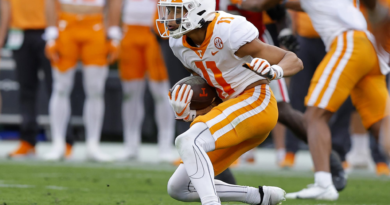How Luka Doncic found another gear this season
Luka Magic.
What’s that mean?
To some, it means that Luka’s game is magical.
To others, it might mean that Luka is a bit like a modern-day Magic Johnson.
Wherever you land on the nickname, there’s no doubt that we’re seeing more Magic out of Luka Doncic this season than we’ve ever seen before. Doncic currently leads the league in fantasy basketball points, both average and total, putting up 63.2 FP/G with 2,213 FP on the season, well ahead of second place Nikola Jokic (60.0 FP/G and 2,041 FP total) in each category with no one else within shouting distance.
Last season, Doncic was sixth by average and seventh by total, almost 10 FP/G behind leader Jokic.
So…what’s happened so far this season? Where has Doncic found all of this extra magic?
The first answer is the least quantitative, but it’s easy to see: He came into this season in visibly better shape than he’s ever entered a season. Luka has a reputation for playing himself into shape as the season goes along and reaching peak condition going into the postseason.
Being in less than peak shape obviously affects what a player can do on a game-to-game basis, particularly for a player like Doncic who is at the center of just about every offensive possession for the Mavericks. Because he’s fitter, he can just do more on a game-to-game basis, and at a higher level.
In addition, being in not-peak shape makes a player more susceptible to injury. Doncic has missed double-digit games in three of his first four NBA seasons, including a career-most 17 absences last season.
This season, Doncic has played in 35 of the Mavericks’ 38 games thus far, with none of the absences consecutive and all seemingly for maintenance purposes. And he’s doing this while averaging a career-high 37.0 MPG, just giving him more time and opportunity to produce numbers than he’s ever had before.
With that said, it’s not just volume. Doncic’s on-court efficiency is at career-best levels as well. He is averaging 46.4 points per 100 possessions, almost five more PP100 than his previous career-best of 41.5 PP100 in his sophomore campaign. He’s simultaneously averaging a career-low 4.9 TO P100, a full 1.5 TO P100 fewer than last season.
He’s shooting career bests of 50.7 FG% and 35.9 3P% for a career-best true shooting percentage of 61.9 TS% (composite shooting percentage that accounts for field goal, 3-point and free throw percentages). Even his defensive numbers of 2.3 steals per 100 and 0.8 blocks per 100 are career bests.
Let’s take a look at what Luka’s doing on the actual court this season that he’s never done before.
For one thing, his scoring has dramatically improved from the mid-range off the dribble. According to Second Spectrum, Doncic’s four most common shot-types for the past three seasons are the stepback, the driving layup, the pullup jumper and the driving floater.
Doncic has an effective field goal percentage (EFG%, accounting for FG% and 3P%) of 53.5 EFG% on stepbacks this season, mildly up from the 52.2 EFG% he posted on those shots over the two previous seasons.
Similar story with driving layups, where he’s improved from 62.9 EFG% in the last two seasons up to 66.3 EFG% this season.
But, the biggest difference has come with driving floaters and pullup jumpers, where he’s improved from below-average marks of 49.9 EFG% and 47.8 EFG% respectively over the previous two seasons up to sparkling marks of 62.2 EFG% and 54.5 EFG%, respectively, this season.
Why is Doncic operating so effectively in the middle of the court this season? In part, because there is a lot more open space to work with. The Mavericks lost Jalen Brunson over the offseason, and one of the outcomes is that they have leaned even further into their dramatically Luka-centric offense where he’s surrounded purely by spot-up shooters.
When with the Mavs, Brunson’s two most common shot types were driving layups and pull-up jumpers. He was creating for himself off the dribble. This season, starting lead guard Spencer Dinwiddie’s two most common shot types are the driving layup and the catch and shoot, illustrating that the Mavs’ lead guard is more likely to spot up and let Luka do work this season than before.
In fact, outside of Luka, all seven of the Mavs’ next most frequent shooters have “catch and shoot” as one of their two most common shot types. And the main shooters are really knocking down those opportunities at a high clip.
Dinwiddie is knocking down his catch and shoot opportunities at a clip of 73.3 EFG%, compared to Brunson’s 62.0 EFG% in a Mavs uniform.
New primary scoring big man Christian Wood is knocking down his catch and shoots at 72.2 EFG%, compared to the 54.8 EFG% that Kristaps Porzingis shot in his catch and shoot opportunities with the Mavs.
With both Dinwiddie and Wood knocking down long-range jumpers at great volume and efficiency (Dinwiddie’s 2.6 3PG and 40.9 3P% are both career bests, Wood 1.8 3PG on personal-best 40.3 3P%), opposing teams simply cannot collapse on Luka in the paint without getting repeatedly burned. And we see what Luka is doing with the extra space.
So, in summary, Luka Doncic came into this season in the best physical condition we’ve seen in years, if not ever, and is consequently able to play a career-high number of minutes while maintaining the best health of his career. The Mavericks have adapted their system to lean even further into Luka’s Magic-like ability to create team offense and have surrounded him with a supporting cast who are thriving in their catch and shoot roles. Which, in turn, creates more space in the middle of the opposing defenses for Doncic to operate, and he’s finishing at career-best rates in those areas of the court.
What’s the end result?
Luka Magic.
P.S. In his last five games of 2022, Doncic averaged a 45.6 PPG, 11.2 RPG, 10.2 APG triple-double with three 50-point games, highlighted by his video game-like 60-point, 21-rebound, 10-assist triple-double against the Knicks. It is exceedingly possible — and scary to contemplate — that for Luka Doncic, his best performances of this season may very well still be yet to come.




